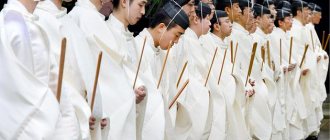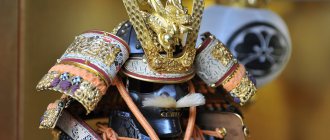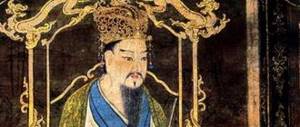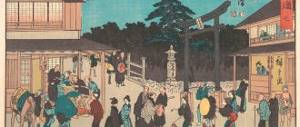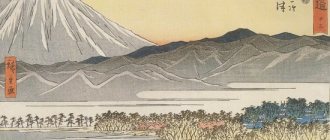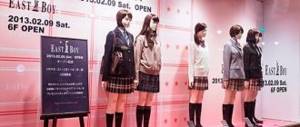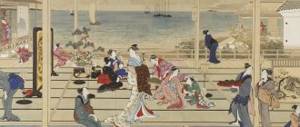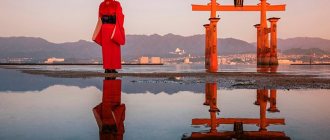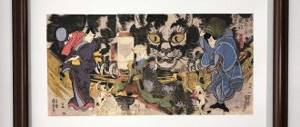Japanese creation myth
In Japanese mythology, there are two deities Izanagi and Izanami. They are the creators of Japan and its gods. Izanagi and Izanami are known through the Kojiki (Records of Ancient Affairs) and Nihongi (Chronicles of Japan).
The first gods Kunitokotachi and Amenominakanushi gave birth to two divine beings - Izanagi and Izanami and instructed them to create the first earth. To help them do this, Izanagi and Izanami were given a jeweled spear called Ame-no-nuboko (heavenly spear). Then these two deities went to the bridge between heaven and earth, Ame-no-ukihashi "floating bridge of heaven" and dipped their spear into the sea. When drops of salt water fell from the spear, the island of Onogoroshima was created. They descended from the sky bridge and went to this island and became husband and wife.
They were the only deities from the seven divine generations who were endowed with the ability to give birth to new gods. According to legend, Izanagi and Izanami, having erected a heavenly pillar called Ame-no-mihashira, walked around it in opposite directions for the wedding ceremony, and when they met on the other side, Izanami said the first greeting. After which they had two frail and sick children: Hiruko (leech) and Awashima (weak island), they were not considered deities, but were treated as children corrupted by the devil. They put the children in a boat and sent them out to sea, and then turned to the gods asking them to advise them what they had done wrong. They were told that the male deity should be the first to speak during the marriage ceremony. So Izanagi and Izanami walked around the pillar again, this time Izanagi, when they met, spoke the word for the first time, and their marriage was finally successful and fruitful.
Izanami soon gave birth to eight beautiful children who became the islands of Japan. Izanagi and Izanami created many gods and goddesses, mountains, valleys, waterfalls, streams, winds and other natural phenomena of Japan. However, during the birth of Kagutsuchi, the god of fire, Izanami was scorched by his flames, weakened and became very ill. As she lay there, she continued to produce gods and goddesses, and from the tears of grief-stricken Izanagi other deities emerged. Soon Izanami left him. In anger, Izanagi divided Kagutsuchi into eight parts, which later became the eight fiery volcanoes.
Yearning for his wife, he descends into the Yomi-no-kuni (underworld) in the hope of saving his wife. At first, Izanagi could not see her because the shadows hid her appearance. He asked her to come back with him. But it was too late, she tasted the food cooked in the oven of the Underworld, which made her return impossible. When they met, Izanami begged him not to look at her and not to light a fire, but Izanagi, full of desire to see his wife, broke her covenant. While Izanami was sleeping, he took a comb that was tied to her long hair and set it on fire like a torch. Under a sudden burst of light, he saw an eerie sight. Now a monster appeared before him in a hellish state with an ugly, rotten face. With faces devouring her once beautiful body. Screaming terribly, Izanagi could not contain his fear and began to run, intending to return to life and abandon his wife killed by death.
Izanami woke up, screamed and was furious at her husband’s betrayal. Wanting to avenge her shame, she sent the lightning god Raijin and the terrible eight witches of Yomotsu-shikome, the inhabitants of the underworld, after him. When Izanagi realized that he could not escape, he threw off his black headdress, which turned into grapes, the creatures began to devour him and slowed down the pursuit, then he broke off the teeth of his sacred comb Yutsu-tsuma-gushi and threw them, the broken teeth turned into shoots bamboo, and forced the evil Shikome to stop and eat the greens, which allowed Izanagi to escape, but now the witches were joined by a large army of 1,500 creatures, led by eight thunder deities. Izanagi fought back with all his might with his Totsuka-no-Tsurugi saber, but still they pursued him until he climbed to the top at the entrance to the underworld, and threw three peaches, causing his pursuers to retreat. After this, Izanami herself gave chase, but Izanagi managed to escape from the entrance and push a boulder into the mouth of Yomosuhirasaka, a cave that was the entrance to the kingdom of the dead Yomi. In anger, Izanami shouted out because of this impenetrable captivity of Izanagi that if he left her, she would destroy 1000 living every day. To which he proudly replied that he would save 1,500 people born on earth every day. And he asked to forgive him and dissolve their marriage. This is how life and death came to earth.
Izanagi soon felt tired and unclean after being freed from the underworld and communing with the dead, and he took a bath to cleanse himself. Many gods and goddesses, both good and evil, emerged from the discarded clothes while Izanagi was bathing. The sun goddess Amaterasu appeared from his left eye, the moon god Tsuki-yomi appeared from his right eye, and the wind god Susano-yo emerged from his nose. Proud of these three noble children, Izanagi divided his kingdom of the living among them.
Origins
The mythology of any country is related to its history, geographical location, religious diversity and cultural values. Japan for a long time remained a closed territory, which came into contact only with its close neighbor - China, and therefore has a completely unique, original mythology.
In addition, serious disasters always awaited Japan - volcanic eruptions, earthquakes, tsunamis, typhoons, and therefore the existence of these phenomena was associated with some higher powers or demons.
The mythology was based on Buddhist views that came from the Celestial Empire, the original Japanese Shinto religion and the beliefs of the common people. Thus, Shinto traditions, where there is a huge number of different spirits, the so-called kami, mixed with characters and deities from the pantheon of the Buddha’s teachings, as well as heroes of folk legends - this is how a single system of myths emerged, sometimes strange and incomprehensible to Western people.
Japanese gods of Shintoism
Myths have also been preserved in written form - for example, there are several literary sources from which you can learn the most interesting legends and put together an overall mythical picture:
- “Kojiki” is an ancient work, also known as “Notes on Events in Antiquity”, contains a collection of myths, tales, and songs about the gods.
- “Shintoshu” is a work of the 14th century, which explains from Buddhism and Shinto how different gods arose.
- “Hotsuma Tsutae” is an epic poem that presents legends viewed from a different, unconventional point of view.
- “Nihon Seki” is a written monument dating back to 720, detailing the life of the country and the emperors.
By the way, the emperor has been highly revered in Japan since ancient times, so it is not surprising that he and his family members became heroes of legends and epics. Moreover, tenno - which is what the emperor is called in Japan - is translated as “divine ruler” or “lord from heaven.” It was believed that the ancestors of all emperors were the first gods.
Naruhito is the current Emperor of Japan
Popular culture
Of course, the tale of Izanagi is well known, and he appears frequently in popular culture:
- Izanagi is the namesake of an ancient tectonic plate that was displaced about 60 million years ago in the Pacific Ocean;
- Izanagi is the name of a genjutsu that prevents injury in the Naruto manga/anime. Ultimately, his use for bad purposes leads to the destruction of the Uchida clan;
- Izanagi appears relatively unchanged compared to his mythical origins in the pages of Marvel Comics;
- Izanagi is a demon from the Megami Tensei video game series, most prominently appearing in Persona 4;
- In Destiny 2, Izanagi's Burden is a powerful sniper rifle.
Family
Izanagi and his sister-wife Izanami are the seventh generation of Kamionanayo and the children of Omodaru and Kashiko-ne. Together with Izanami, Izanagi painted the islands of Japan from the sea; Thus, the two deities actually gave birth to the islands, which in turn are considered their children. The islands in this creation myth are generally considered to be Kyushu, Shikoku and Honshu, as well as the smaller islands that surround them. Izanagi then gave birth to the first great generation of kami, culminating in the birth of the fire god Kagutsuchi, who killed Izanami.
Cleansing himself from this tragedy, Izanagi gave birth to Amaterasu, Tsukuyomi and Susanoo, the three most important gods in the Japanese pantheon. Through Amaterasu, he is the ancestor of the Japanese imperial family.
The Legend of Amaterasu and Susanoo
There are two almost opposite myths about these deities, who were brother and sister to each other. According to one of them, Susanoo treated his father Izanagi very poorly, and for this the supreme gods decided to send him to the kingdom of Yomi.
Susanoo agreed reluctantly, but first wanted to say goodbye to his sister, with whom he had always been at enmity. Amaterasu doubted the purity of his intentions and challenged him to battle.
Japanese sun goddess Amaterasu
During the battle they had to create deities. The prize was to belong to the one who created beings endowed with the greatest nobility. The goddess created three women, and Susanoo - five men from her sister's necklace.
But since the necklace belonged to Amaterasu, she declared that men should treat her creations, and men should treat Susanoo's creations. The brother became angry and in anger committed many sins, among which was tearing apart a horse and skinning the living flesh.
Amaterasu was offended by this act, took refuge in a cave, and then the entire planet was covered in impenetrable darkness. For this, higher powers sent Susanoo to the kingdom of the dead, and the goddess of entertainment Ame no Uzume was able to entertain the girl and bring her out of hiding. Since then, light has returned to the world again, and Ame no Uzume has become the patroness of the dawn.
According to another legend, Amaterasu and Susanoo were not just brother and sister, but spouses, and there was no enmity between them. But one day the young man missed his mother, who was in Yomi, and wanted to go to her. To do this, he began to send troubles to people so that others would put him to death.
Japanese elemental god Susanoo
In the end, the girl became sad, disappeared into the cave, and the light disappeared with her. The gods were worried, but were able to cheer her up and return her to normal life.
Amaterasu herself is considered the mother of the imperial dynasty. Her full name is Amaterasu Omikami, which means "majestic deity who illuminates the sky." There is also a legend that it was she who taught the people of Japan to grow rice and produce silk by working on a loom.
Goddess of creation
Kunitokotachi and Amenominakanushi, the first gods, brought Izanagi and Izanami into existence. These two newly summoned divine beings were tasked with creating the first earth. They were given a special spear decorated with precious stones, which was called Ame-no-nuhoko. Izanagi and Izanami both went to the bridge between earth and sky, Ame-no-ukihashi. There they churned the sea with a spear. Onogoroshima (“self-forming earth”) was created from drops of salt water that fell from a spear as the sea churned. They then made this island their home.
